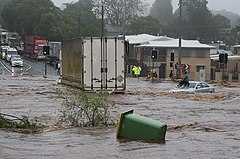Over the past decade, the notion of resilience has emerged as a prevailing paradigm for planning that considers how people and places can survive, adapt, and grow in the face of today’s pressures, where globalization, urbanization, and climate change have combined to increase our vulnerability to a range of shocks and stresses.
Given the tremendous interest in and commitment to building resilience, we need tools that help communities illustrate and quantify the link between resilience-inspired investments and improved well-being.
The net benefits from these investments are the resilience dividend.
Building resilience is about people and places being better prepared to withstand catastrophic events—both natural and manmade—and able to recover more quickly and emerge stronger when those events occur. It may also provide additional benefits even in the absence of those events.
The resilience dividend is the sum of benefits, over time, from a project investment based on resilience principles compared to one that is not.
It is the difference in value between a resilience approach and business-as-usual - the “bonus” we receive from investing in a project designed to build resilience.
The Rockefeller Foundation, which has invested more than half a billion dollars in resilience-building over the past decade, received an overwhelming number of requests for how to quantify the resilience dividend.
With support from the Foundation, the RAND Corporation developed the “Resilience Dividend Valuation Model”, a framework that provides communities with a structured way to frame and analyze resilience policies and projects.
The Resilience Dividend Valuation Model combines elements of project evaluation and economic valuation, and can be used to guide decision-making, planning, and action for resilience investments.
It offers a framework for policy makers and practitioners to carefully map out how a resilience investment will affect a community and its well-being.
It helps stakeholders understand and illustrate the causal relationships between elements of human and natural systems that are unavoidably complex and evolve over time.
 |
| https://en.wikipedia.org/wiki/2010%E2%80%9311_Queensland_floods |
What do communities gain from adopting resilience approaches?
There are two main benefits from resilience approaches:
- lower future costs from a shock (or set of shocks) or stressors; and
- social, economic and environmental co-benefits even in the absence of a shock or stress. Co-benefits include enhanced social cohesion, better environmental quality and ecosystem services, and additional public goods (for example, space for public use).
These elements include the resources a community has, the goods and services those resources provide, and how those goods and services drive the level of well-being. It also requires an understanding of how stakeholders in the system might behave in response to changes in system elements.
Resilience investments can change the resources a community has, relax constraints, or increase opportunities for stakeholders.
The linkages between elements of a system are critical, since they can be leveraged to create additional co-benefits and complementarities.
The RAND team completed a series of case studies designed to both demonstrate how the Resilience Dividend Valuation Model can be applied, and to draw out lessons learned about the challenges and opportunities of estimating the resilience dividend.
One of the case studies looked at investments in climate adaptive infrastructure and social systems in eight towns in Bangladesh.
The goal of these investments, which was co-financed by the Asian Development Bank (ADB), was to improve long-term outcomes related to natural disasters by investing in physical infrastructure, supporting community decision-making, and enhancing municipal government capacity through a multi-year project.
Although the Bangladesh projects are not yet complete, RAND applied the Resilience Dividend
Valuation Model using a pre-project approach to estimate the expected resilience dividend.
Using ADB data, RAND analyzed the goods and services the projects will produce, ranging from water quality and flood protection to general economic activity and municipal services, and the team looked at how those goods and services will be allocated, including through gender-inclusive decision making.
Estimating the full resilience dividend required more data than was available, yet the case highlighted the opportunities for using the model to gauge the potential impacts of resilience investments.
The Foundation’s support to RAND resulted in a modeling framework that offers us a starting point – one that can be built upon through collective expertise, as well as trial-and-error.
We’ve learned a lot from trying to estimate the resilience dividend of an investment and have concluded that quantifying the resilience dividend of an investment:
- Is a skill and an iterative process, not an equation or a black box.
- Takes rigorous systems analysis, and is challenging especially when there is no shock.
- Is a data- intensive endeavor: quantitative and qualitative data are critical to arriving at an estimation of the dividend.
- Demands capturing critical elements beyond economic and financial benefits: social capital, for example, is important for behavior change within a system and critical to valuing the dividend.
- Requires a careful study of distributional effects: a positive resilience dividend does not necessarily imply positive net benefits for all stakeholders.
The Practitioner Guide walks through the motivation and mechanics of the model to introduce the framework and approach.
A more detailed report, including technical explanations, is available for those interested in delving deeper into the approach and features six detailed case studies designed to explain how the model can be applied across settings, as well as the opportunities and challenges of calculating the resilience dividend.
by Sundaa Bridgett-Jones, Senior Associate Director, The Rockefeller Foundation
August 2, 2017
Zillient.org https://www.zilient.org
No comments:
Post a Comment